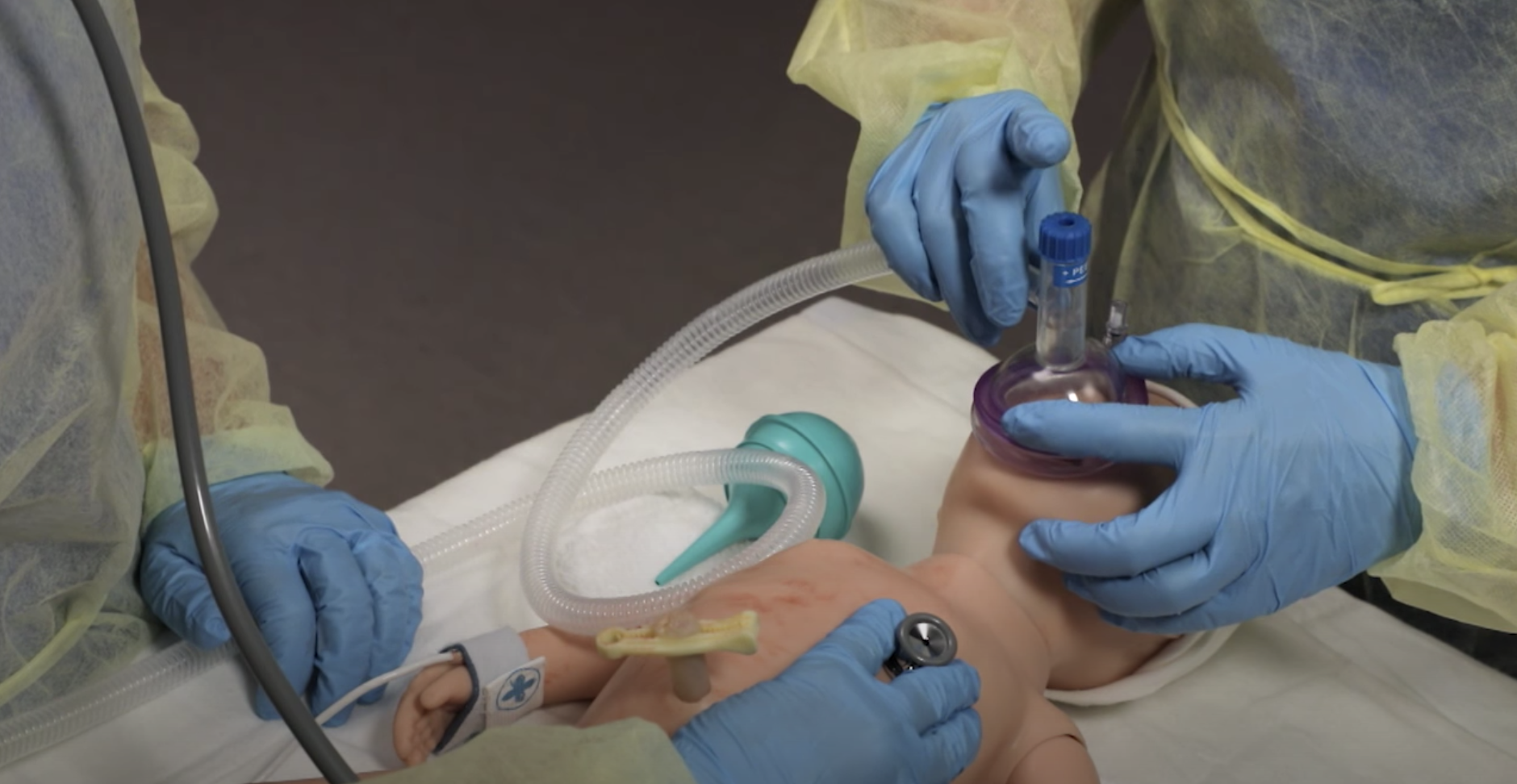Positive Pressure Ventilation Equipment
Self-Inflating Bag
The self-inflating resuscitation bag spontaneously expands and fills with gas after the delivery of each breath without the need for any compressed gas source. When the bag is released, it recoils and entrains fresh air from the room into the bag. The self-inflating bag provides room air, which contains 21% oxygen, but tubing on the bag may be attached to an oxygen source to augment supplementary oxygen delivery during PPV.
When using a self-inflating bag, the respiratory rate is determined by how often the provider squeezes the bag. Inspiratory time is a function of how quickly or slowly the bag is squeezed. PIP is a function of how hard the clinician squeezes the self-inflating bag. A PEEP valve can be attached to the self-inflating bag to allow PEEP delivery. PEEP is typically set by adjusting the valve itself to the desired PEEP setting.
A pop-off valve is included on most self-inflating bags to limit peak pressure delivery. It will “pop off” at levels of 30–40 cm H2O. At times, the provider may need to disable the pop-off if a greater PIP is required to effectively move the baby’s chest.
When not being squeezed, self-inflating bags have a closed valve at the mask port. They do not permit the free flow of gas to the patient. Consequently, the team cannot use a self-inflating bag to administer CPAP or free-flow oxygen. Some bags have an open reservoir at the “tail” of the bag that can be disconnected or turned toward the baby to provide free-flowing oxygen.
Key Takeaway
PEEP can be administered through a self-inflating bag, but CPAP and free-flow oxygen CANNOT.
Flow-Inflating Bag
A flow-inflating bag is commonly used in the surgical setting; hence it is often referred to as an “anesthesia bag.” A flow-inflating bag only fills in the presence of a compressed gas source. The bag will also only fill when the outlet to the patient is sealed.
In the delivery room, the flow-inflating bag is typically connected to the flowmeter on a blender. Unlike a self-inflating bag, the flow-inflating bag does not pull in air from the room, so the percent of oxygen dialed in on the blender is the percent of oxygen the baby receives with each breath.
The ventilation rate is determined by how often the provider squeezes and releases the bag. PIP is a function of the flow rate into the bag and how hard the provider squeezes it. PEEP is generated by restricting flow at the end of each breath.
Safe PPV requires that PIP and PEEP be measured during each breath with a manometer. Some flow-inflating bags have a manometer built-in; others have connections for external manometers. Regardless, a manometer’s attachment site is a potential cause of a gas leak and bag failure if the manometer is not connected or is not connected firmly.
Key Takeaway
PEEP, CPAP, and free-flow oxygen can be administered through a flow-inflating bag.
The flow inflating bag has an open outlet at the patient end and is suitable for delivering PEEP, CPAP, and free-flow oxygen without any modifications.
T-Piece Resuscitator
A T-piece resuscitator uses valves to regulate the flow of gas directed toward the patient. It requires a compressed gas source like the flow-inflating bag.
Key Takeaway
PEEP, CPAP, and free-flow oxygen can be administered through a T-piece resuscitator.
The clinician delivers each breath by occluding the gas escape opening on top of the T-piece cap with their finger. Inspiration occurs when the cap is covered, and exhalation occurs when the cap is uncovered. Inspiratory time is a function of how long the cap is occluded.

A provider using a T-piece resuscitator to deliver positive pressure ventilation.
The T-piece resuscitator has a PIP control knob that is set to the desired PIP. One advantage of the T-piece resuscitation is that PIP delivery is fixed and constant based on where the clinician sets the PIP. PEEP is also set and constant. The provider adjusts PEEP by turning the cap at the patient end of the circuit. A built-in manometer displays the inspiratory and expiratory pressures.
T-piece resuscitators also have a pressure relief knob. It is a protective device that prevents the user from increasing the PIP beyond a preset value to prevent volutrauma or barotrauma. Finally, the port to the patient is always open, so free-flow oxygen and CPAP can be readily provided with the T-piece resuscitator.